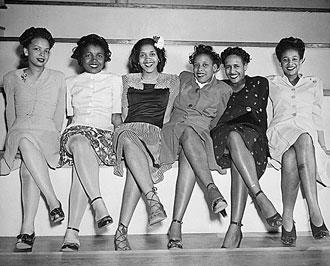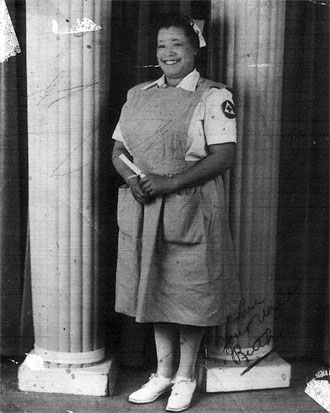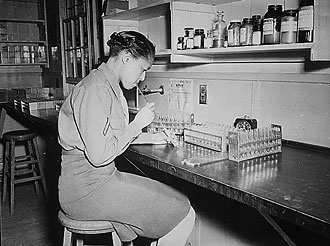




Advanced Search
Dress Up | 1st Person | African American Map | Now Read This | Magic Lens | Tool Videos | Architecture | e-Postcards | Chronologies
|
First Person > Dr. Ruth B. Loving Dr. Ruth B. Loving - 1941-1945: The USO, and the Massachusetts Women's Defense CorpsRuth Loving's service during World War IIRuth Loving and her family supported the World War II home front effort in a variety of ways. In addition to joining the Massachusetts Women's Defense Corps and dancing with soldiers at Westover Field, she volunteered for the USO. Ruth was also a Senior Aide for the Red Cross... Learn more about Dr. Ruth B. Loving: View a timeline of her life and listen to her full interview. Stories by this speaker

Six young women pose for the camera at the April 1944 Spring Formal Dance at the Seattle Naval Air Station, Seattle, Washington. Ruth contributed to the World War II homefront effort in a variety of ways. She recalls the time that she and the other young women of her church were asked to travel to Westover Field in order to dance with soldiers who were stationed there for a day or a week before being sent to the war. Ruth explains, "I remember the first time going with a group…about fifty girls from Springfield, and … we were just as bashful as those young men were. They were being awful careful." "Pin-up girls at NAS Seattle, Spring Formal Dance. Left to right: Jeanne McIver, Harriet Berry, Muriel Alberti, Nancy Grant, Maleina Bagley, and Matti Ethridge." April 10, 1944. Department of Defense. National Archives, Series: General Photographic File of the Deparmtent of the Navy, NAIL Control Number: NWDNS-80-G-23326. 
Ruth served as a Red Cross Senior Aide during World War II. 
The Public Counsel Division of the Office of Civilian Defense published this photogram in 1943. This family has made a significant commitment to the World War II home front effort. At least four of its six members are volunteers for their local Civilian Defense council. The man to the left wears the insignia of the Air Raid Wardens. He has been trained, in part, to help during community-wide blackouts. Blackout regulations were non-negotiable, and, once accomplished, hid or eliminated lights of a city or town thereby decreasing its nighttime vulnerability. The mother’s armband may contain an illustration of a coffee cup within a white triangle. This is the insignia of the Emergency Food and Housing Corps. She would provide emergency welfare services to the homeless and, in the event of an emergency, to the general public. The two young men are members of the Civilian Defense Auxiliary Group. During blackout conditions or an air raid, they would have assisted with one of a number of emergency services. In addition to dancing with soldiers at Westover Field, during the war Ruth joined the Massachusetts Women’s Defense Corps and was a Senior Aide for the Red Cross. Ruth in her Red Cross Uniform, courtesy of Ruth Loving Office for Emergency Management , Office of Civilian Defense, Public Counsel Division, "V" home campaign, Washington, D.C. October 1942. National Archives, NAIL Control number NWDNS-71-OCD-140. 

Members of the Massachusetts Women's Defense Corps wore a cap insignia that featured an interlocking M and W between the letters D and C below an eagle inspired by the Great Seal of the United States. Ruth Loving enlisted in the Massachusetts Women's Defense Corps on August 13th, 1943, and she served in that trained state militia through the end of World War II. Although members of the Corps remained civilians, Ruth felt her training to be as rigorous as military training. She remembers practicing military drills, as well as watching her "Ps and Qs" around Master Sergeant Stella P. Thomas. The Massachusetts Women's Defense Corps was active between 1941 and 1946. It was originally aligned with the senior military officer of Massachusetts and in 1944 with the Massachusetts State Guard. The Massachusetts Women's Defense Corps personnel provided medical, firefighting, air raid alert, transportation, canteen, and communications services during World War II. In the year following the activation of the Massachusetts Women's Defense Corps, the nation established the Women's Army Auxiliary Corps (WAAC) later renamed the Women's Army Corps (WAC). During World War II, over 150,000 WACs supported the American military at home and overseas. Ruth Loving was one of four African Americans serving in her integrated detachment of the Massachusetts Women's Defense Corps. The Women's Army Corps (the WAC), in contrast, was segregated. 1945 Massachusetts Women's Defense Corps photo courtesy of Ruth Loving. Photograph of Massachusetts Women's Defense Corps cap insignia courtesy of the Massachusetts National Guard Museum and Archives. 
Women's Army Corps Private First Class Johnnie Mae Welton works in the Fort Jackson Station Hospital in Fort Jackson, South Carolina. Women such as Ruth Loving as part of the Massachusetts Defense Corps, and Johnnie Mae Welton as part of the Women's Army Corps, performed numerous necessary services in support of the national defense during the Second World War. Ruth and all other members of the Massachusetts Defense Corps served in the canteen unit. Ruth also served in the "field of communication[s]," for which she learned Morse Code and was trained as a radio operator. "Pfc. Johnnie Mae Welton, Negro WAC, laboratory technician trainee, conducts an experiment in the serology laboratory of the Fort Jackson Station Hospital, Fort Jackson, SC.", 03/20/1944, National Archives, Local Identifier 111-SC-341534 Story Clip #1:Mrs. Minor Loving moves to Boston with her new husband and obtains a license to sing Wait for each file to download, then click the arrow to play the audio. My life has been a part of, of people and activities. I um, sang in a youth choir and learned to play the organ when I, I got a little older there, I was playing piano, for accompaniments for people, and I liked music and I got to sing. I got to sing with singing groups. Uh...when I moved up to Boston, ...I got so that ...my husband felt very strongly that I should have something I could do in case he died or something. We were just married; he said, in case he got sick and couldn't do it, he said, I know you sing, and that's when you went out to sing, you just couldn't walk up to the microphone. You had to have a license to sing if you wanted to get...as a group. You just couldn't go up and join a group and sing like you do today. Q: You had a license to sing... You had a license to... Q: ...in a group? Or you had a license to sing...on the radio. No, you got a license to sing, as a singer. You could sing with any group, see. And um, that's where I started getting the, entertainment license out of Boston, uh, to sing, ...that word, gig...uh...up there. And, uh, when we moved sh...well, we only stayed up in Boston about three years. We moved down to Springfield. I got...known as Ruth Loving, Loving with the Loving Trio. I had the piano, guitar, and bass. And um...music then seemed to be in the field that I was in. Story Clip #2:Dancing with Soldiers for the USO They had built Westover Field for that second world war, you know, out there. And, ... I'll never forget when they built it, we thought it was just gonna be for soldiers and we got notices sent to our churches, asking...they were going to have a pick–up system in Springfield, where they pick up young women that were eligible, eighteen years old and over, to go out to dance with the young men, because some of'em had to stay over the...overnight before they were shipped out overseas. And they wanted to have entertainment. That was before there was a USO, but it became the USO around the nation, and that...uh, they opened up these clubs on the ...areas where the ...troops were at ...I remember the first time going with a group...about fifty girls from Springfield, and ... we were just as bashful as those young men were. They were being awful careful. We...saying, oh brother. But, uh, dancing got us together... Q: Did you dance as a performance, do you mean? Or... No, no. Dancing. You were girls going there to be friends with the soldiers who would be there overnight, stationed overnight, or during the week, or workers who worked there. There were thousands of them coming in. And they would...they just didn't want the young men just to come in and sit in there...in the lounges, with no activity going on. And they were trying to figure out how to ...let them stay overnight, and yet enjoy what they were doing before they got in...I guess....that, there, uh, unhappy... situation by being a part of the war, you understand. And they asked for volunteer girls, out of the churches first, and then you had to have an age group...belong to a group, and they sent busses in from Westover field to pick you up, either at the churches, or clubs, uh...community centers here. And there...it ended up you had maybe ...eight or nine hundred girls out there. That's a lot of people filling up that big club out there. And, ...we went out there and ...that activity was very exciting. Story Clip #3:Life on the World War II Homefront I was singing then, as ...Carl Loving and the Trio. I also ... became a part of the National Guard there. Um...back in the year, let's see, early fifties, there. I remember they were ... calling for... women to supplement the National Guard in Massachusetts state. [Ruth is referring to her service in the Massachusetts Women's Defense Corps. She joined in August 1943 and served through the end of World War II.] They needed women who could take care of officers, communication, paperwork, and stuff. So let their National Guard people go, and o'course we had this new Westover Field out here. Story Clip #4:The Massachusetts Woman's Defense Corps Q: Would you like to talk about your military service? Yeah. Military service was fine. I remember when we...they asked us...it must've been about...we had to organize everything from the captain, the whole unit...uh...we were known as the Massachusetts Women's Defense Corps. And we were in ...different units across the state, in conjunction with a National Guard unit ...We first trained out of the one–oh–two unit. We were part of their... the Women's Guard, and we worked for a while out of Chicopee where the Air Force unit, uh, Air Force Guard unit was working out of Chicopee at first, and then they came into Springfield to work because it seemed like it was a bigger army that we have down on Howard Street. And, then we began to train down on Howard Street. One of the unique things about though...the office of the Massachusetts Women's Defense Corps... they were secret offices you had throughout the state for emergencies, that the National Guard had, was located ... where the new ...courthouse is in Springfield, Massachusetts. We were located in the Alexander Houses, they called it, but they had to move to another section there in Springfield there, down the street. We had our headquarters in that building, although no one s'pose'd know it. Story Clip #5:While serving in the Massachusetts Woman's Defense Corps, Ruth learns to communicate using Morse Code I was in the field of communication, and the canteen unit, ...they insisted that all women take a canteen course because they didn't know when we might have to just fall in and learn how to just set up the coffee and, and food for the military men. ...But they also suggested other areas we could work in, officers...took communi... I took communications. Uh, I was a little surprised when I found out communication also meant learning the Morse code. Q: Oh... Dah, dah, dah dit dit dah dah. You had to learn the whole alphabet! After a while, after maybe about seven or eight months, you got it...kinda halfway knew what you were doing... Q: Do you still remember the whole alphabet in Morse code? No. Remember, that's been almost sixty years ago? No, no, no. Only thing I remember is S–O–S. Dah, dah, dit dit, no...dah, dah dit...dah dah dah...s'posed to be three dah dahs, and a dit, and a three dah, dah, dahs, that's for S–O–S, okay? Now that's what you did for anybody when anything went wrong. And then you had to...you shorten words almost like um...mmmmm....well, like, "soon" would be S–N. So you only do the two and so that when you read it, you had to read it like you knew what letters to fill in. There's a, there's a word for that... but that's what you'd do. You didn't spell words out. Like "would you go?" is W–D YOU Y–U and uh, take out the O, and you had to learn that kind of a ...just ordinary speaking in communication so the other person, the other end would get an idea it's not all the, the S–O–S was certainly for 9–1–1 set up. You couldn't use any other kind, otherwise you use, say the Ws and the Ds in the code word that you use. And it was very, very interesting. They were very consistent with that because they were saying that they couldn't have telephones and things that were going out in the fields and...'cause telephone was big business then, but...they couldn't have'em out on the fields. Only the field manager had...carried it...they had some kind of little box set up where they carried the phones out with them in their cars and et cetera. Uh, but we did military...we did military drills, we did the ...parade drills...we had to learn the parade language, left turn, right turn, rear uh, rest, uh, cadence and stuff. We had to learn...we had to learn that. And practice and do it when we were called on... to drill ourselves, to drill the ...twenty–five of us, you know. We had captain, uh, captain, lieutenant, and a lieutenant and captain and all this stuff, just so they had a regular thing–a–ma–jigs, master sergeant, who was Stella P. Thomas at the time, and boy she was a master sergeant, too. You come in there with your shoes untied, you'd...you were given the mark down. Uh...given a job, you know, you wouldn't like to do, she'd have you do, and she wasn't kidding, so you had to watch your Ps and Qs. Related ResourcesThe following source file was not found: ebdav/centuries/html/resource/loving1941.html
|
| |
Home | Online
Collection | Things To Do | Turns
Exhibit | Classroom | Chronologies | My
Collection
About This Site | Site
Index | Site Search | Feedback